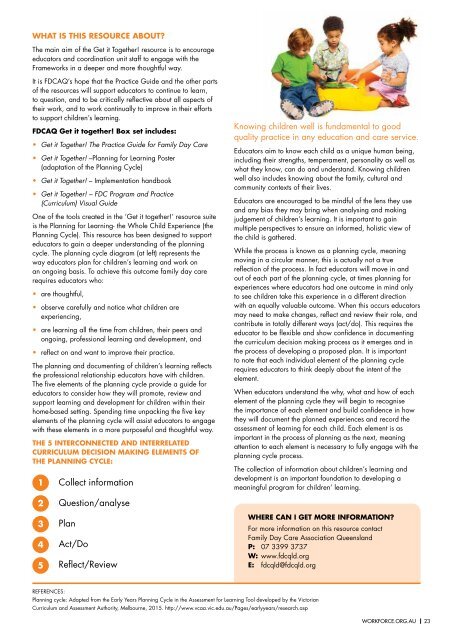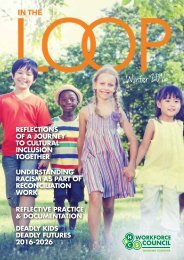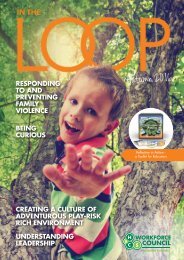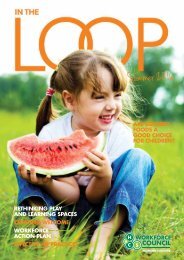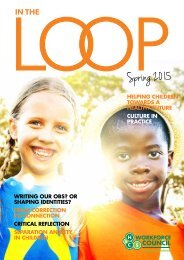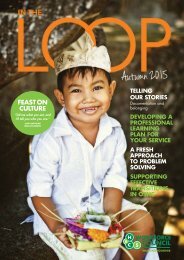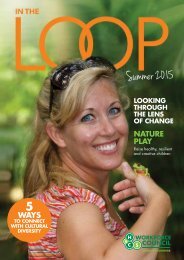The Loop December 2015 Web
Create successful ePaper yourself
Turn your PDF publications into a flip-book with our unique Google optimized e-Paper software.
WHAT IS THIS RESOURCE ABOUT?<br />
<strong>The</strong> main aim of the Get it Together! resource is to encourage<br />
educators and coordination unit staff to engage with the<br />
Frameworks in a deeper and more thoughtful way.<br />
It is FDCAQ’s hope that the Practice Guide and the other parts<br />
of the resources will support educators to continue to learn,<br />
to question, and to be critically reflective about all aspects of<br />
their work, and to work continually to improve in their efforts<br />
to support children’s learning.<br />
FDCAQ Get it together! Box set includes:<br />
• Get it Together! <strong>The</strong> Practice Guide for Family Day Care<br />
• Get it Together! –Planning for Learning Poster<br />
(adaptation of the Planning Cycle)<br />
• Get it Together! – Implementation handbook<br />
• Get it Together! – FDC Program and Practice<br />
(Curriculum) Visual Guide<br />
One of the tools created in the ‘Get it together!’ resource suite<br />
is the Planning for Learning- the Whole Child Experience (the<br />
Planning Cycle). This resource has been designed to support<br />
educators to gain a deeper understanding of the planning<br />
cycle. <strong>The</strong> planning cycle diagram (at left) represents the<br />
way educators plan for children’s learning and work on<br />
an ongoing basis. To achieve this outcome family day care<br />
requires educators who:<br />
• are thoughtful,<br />
• observe carefully and notice what children are<br />
experiencing,<br />
• are learning all the time from children, their peers and<br />
ongoing, professional learning and development, and<br />
• reflect on and want to improve their practice.<br />
<strong>The</strong> planning and documenting of children’s learning reflects<br />
the professional relationship educators have with children.<br />
<strong>The</strong> five elements of the planning cycle provide a guide for<br />
educators to consider how they will promote, review and<br />
support learning and development for children within their<br />
home-based setting. Spending time unpacking the five key<br />
elements of the planning cycle will assist educators to engage<br />
with these elements in a more purposeful and thoughtful way.<br />
THE 5 INTERCONNECTED AND INTERRELATED<br />
CURRICULUM DECISION MAKING ELEMENTS OF<br />
THE PLANNING CYCLE:<br />
1<br />
Collect information<br />
Knowing children well is fundamental to good<br />
quality practice in any education and care service.<br />
Educators aim to know each child as a unique human being,<br />
including their strengths, temperament, personality as well as<br />
what they know, can do and understand. Knowing children<br />
well also includes knowing about the family, cultural and<br />
community contexts of their lives.<br />
Educators are encouraged to be mindful of the lens they use<br />
and any bias they may bring when analysing and making<br />
judgement of children’s learning. It is important to gain<br />
multiple perspectives to ensure an informed, holistic view of<br />
the child is gathered.<br />
While the process is known as a planning cycle, meaning<br />
moving in a circular manner, this is actually not a true<br />
reflection of the process. In fact educators will move in and<br />
out of each part of the planning cycle, at times planning for<br />
experiences where educators had one outcome in mind only<br />
to see children take this experience in a different direction<br />
with an equally valuable outcome. When this occurs educators<br />
may need to make changes, reflect and review their role, and<br />
contribute in totally different ways (act/do). This requires the<br />
educator to be flexible and show confidence in documenting<br />
the curriculum decision making process as it emerges and in<br />
the process of developing a proposed plan. It is important<br />
to note that each individual element of the planning cycle<br />
requires educators to think deeply about the intent of the<br />
element.<br />
When educators understand the why, what and how of each<br />
element of the planning cycle they will begin to recognise<br />
the importance of each element and build confidence in how<br />
they will document the planned experiences and record the<br />
assessment of learning for each child. Each element is as<br />
important in the process of planning as the next, meaning<br />
attention to each element is necessary to fully engage with the<br />
planning cycle process.<br />
<strong>The</strong> collection of information about children’s learning and<br />
development is an important foundation to developing a<br />
meaningful program for children’ learning.<br />
2<br />
3<br />
4<br />
5<br />
Question/analyse<br />
Plan<br />
Act/Do<br />
Reflect/Review<br />
WHERE CAN I GET MORE INFORMATION?<br />
For more information on this resource contact<br />
Family Day Care Association Queensland<br />
P: 07 3399 3737<br />
W: www.fdcqld.org<br />
E: fdcqld@fdcqld.org<br />
REFERENCES:<br />
Planning cycle: Adapted from the Early Years Planning Cycle in the Assessment for Learning Tool developed by the Victorian<br />
Curriculum and Assessment Authority, Melbourne, <strong>2015</strong>. http://www.vcaa.vic.edu.au/Pages/earlyyears/research.asp<br />
WORKFORCE.ORG.AU 23


